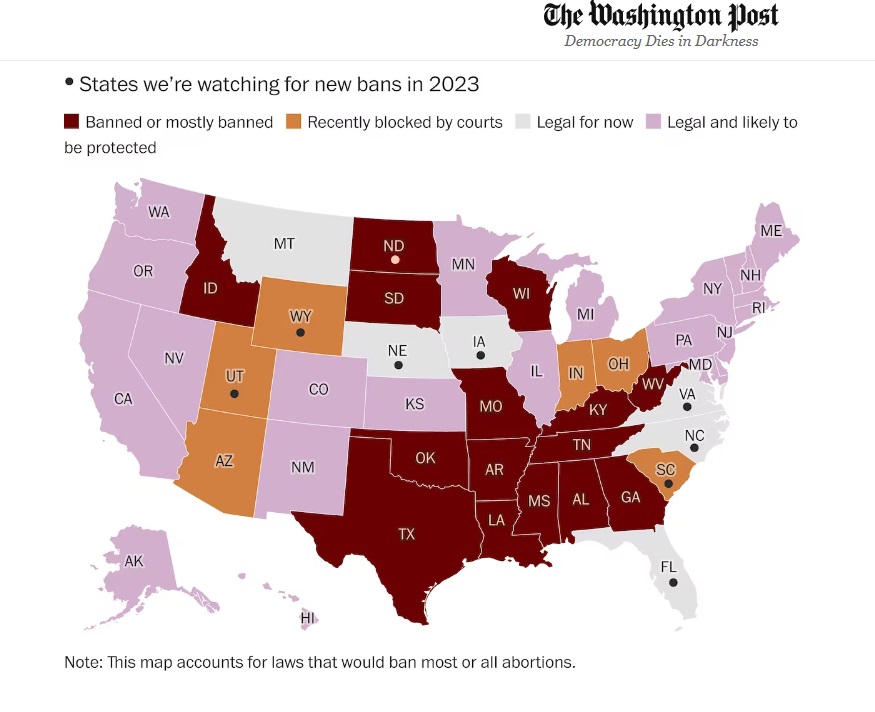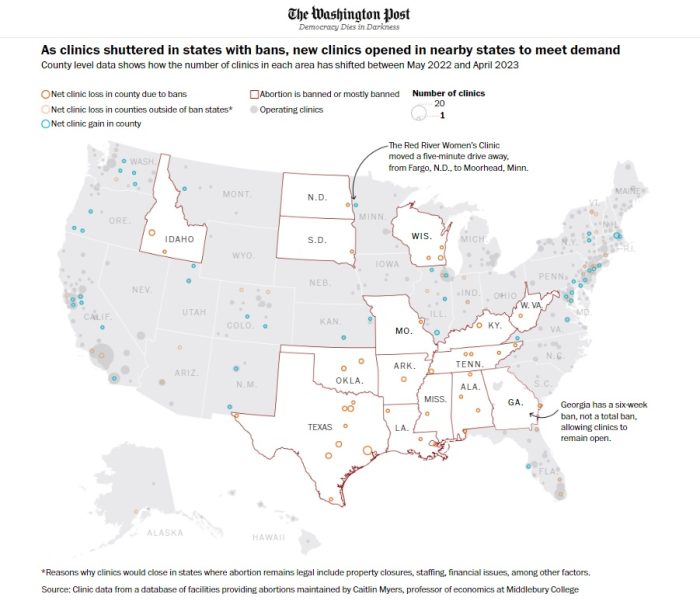Preborn children are now mostly protected from abortion in more than a dozen states, according to a recently released report from the pro-abortion Guttmacher Institute.
The group listed that 13 states currently protect the preborn in law — Alabama, Arkansas, Idaho, Kentucky, Louisiana, Mississippi, Missouri, North Dakota, Oklahoma, South Dakota, Tennessee, Texas, and West Virginia. These are states where “[a]bortion is completely banned with very limited exceptions.” Notably, they added that Idaho, Missouri, and Tennessee each require an “‘affirmative defense,’ meaning a provider has to prove in court that an abortion met the criteria for a legal exception.”
In addition, “as of June 20” abortion is also “unavailable in Wisconsin” because of ongoing legal uncertainty, two Guttmacher Institute executives wrote in Philanthropy.com, and “[a] six-week abortion ban is now in effect in Georgia, and Florida is expected to soon follow suit. Last month, Nebraska and North Carolina approved 12-week bans.” In reality, because the vast majority of abortions take place in the first trimester, a 12-week “ban” isn’t actually much of a ban at all.
The Guttmacher report also claims that nearly 700 legislative bills both for or against abortion have been introduced so far this year, “about half of which would expand access and about half would restrict access.” The news comes as the nation marks the one-year anniversary (June 24, 2022) of the overturning of Roe v. Wade in the Dobbs v. Jackson Women’s Health Organization Supreme Court decision.
“Every state in the country has taken action on abortion in some way,” Planned Parenthood’s political arm claimed, citing 360 pro-life bills being filed thus far in 2023 and more than 350 pro-abortion bills filed this year in 48 states. This is “more than double the amount we saw at this time last year,” Planned Parenthood Action Fund wrote.
One year since #Roe was overturned:
📢 Abortion banned in 13 states
📢 Tens of thousands of people denied abortions
📢 More than 16.5 million people have no access to care in their state
Here’s how state policies from the past year have impacted abortion rights & access ⬇️ pic.twitter.com/cFaiepAIFY
— Guttmacher Institute (@Guttmacher) June 6, 2023
Pro-life measures
So far in 2023, 25 pro-life measures have been “enacted with seven temporarily blocked from taking effect during ongoing lawsuits while one is awaiting a separate state supreme court decision in order to take effect,” Guttmacher claimed.
A research project from the pro-abortion Society for Family Planning (SFP) known as #WeCount claimed that the number of states where abortion is banned increased post-Dobbs from nine states (Alabama, Arkansas, Mississippi, Missouri, Oklahoma, South Dakota, Texas, West Virginia, and Wisconsin) to 13 in the months between July 2022 and March 2023. The additional states included Kentucky and Louisiana (which #WeCount claimed banned abortion in August) and Idaho and Tennessee (which did so in September 2022). In July 2022, abortion was legal beyond six weeks in 39 states, but this number reportedly dropped to 36 by March 2023.

WAPO states that could ban abortion in 2023
In addition to legislation at the state level, Sanctuary Cities for the Unborn ordinances have passed in five cities and one county so far in 2023.
Pro-abortion measures
The Guttmacher Institute’s report also claimed that 30 pro-abortion measures have been enacted in 2023, including “16 shield laws; 5 laws that protect the legal right to reproductive health care; 1 constitutional amendment to appear on the 2024 ballot; 1 requirement for Medicaid to cover abortion; 1 repeal of a total abortion ban.”
New York passed a measure to require abortion pill access on all public and community colleges and university campuses while “Rhode Island passed a law ensuring state funds for abortion coverage to those who qualify for public health insurance, including state employees,” Guttmacher claimed. Abortion expansions occurred in Colorado, which enacted a law targeting pro-life pregnancy help centers while “Michigan repealed its pre-Roe abortion ban” and approved “a state constitutional amendment guaranteeing the right to abortion and other reproductive health services.”
A Biden Administration’s federal proposed rule change to HIPAA — which would add a new category of “reproductive health care” to include abortion and shield abortionists — could soon take effect, while additional “shield laws” were passed at the state level.
In all, according to Guttmacher, 20 states plus D.C. enacted protections for abortionists and 10 states and D.C. enacted 16 shield laws as well, with New York approving such a bill just this week. According to the New York Times (NYT), the bill states that New York courts and officials are not to cooperate with a pro-life state that tries to prosecute or sue an abortionist in New York who provides abortion drugs to a woman in any pro-life state.
“New York’s legislation is expected to have a notable impact. Several [abortion] providers in New York say they plan to send abortion pills to patients in all restrictive states, and a few providers are speaking publicly, which those in other states with shield laws have so far not done,” the Times reported.
Changing abortion landscape
In October of 2022, Guttmacher claimed that within 100 days after the Supreme Court overturned Roe v. Wade, 66 of 79 abortion facilities in 15 states stopped committing abortions, and 26 of those businesses shut down entirely. The Abortion Clinic Network (ACN) stated in December, “When abortion clinics are forced to close, they are very unlikely to re-open.”
Some abortion facility closures were due to horrific conditions or care at the facility, but others have relocated from states where abortion is now restricted to states that have enshrined abortion in law. In Dallas, Texas, Southwestern Women’s Surgery Center, operated by Curtis Boyd, closed permanently; Boyd’s facility in Albuquerque, New Mexico, stopped committing abortions late in pregnancy following a hefty lawsuit over the death of a client.

Abortion clinics shuttered post-Dobbs and some relocated (Image credit: Washington Post)
“Since the Supreme Court struck down Roe v. Wade one year ago this week, we’ve seen the abortion access landscape across the United States change dramatically — for the worse,” the pro-abortion group Advancing New Standards in Reproductive Health (ANSIRH) wrote in an e-mail.
ANSIRH’s “Trends in Abortion Facility Gestational Limits Pre- and Post-Dobbs” found that due to pro-life state laws, “fewer states offered medication abortion in 2022 (37 states + DC) than in 2021 (49 states + DC). Facilities in 13 states did not offer medication abortion as of October 2022.”
Of surgical abortions, ANSIRH claimed, “Due to abortion bans, fewer states had facilities that offered procedural abortion in 2022 (36 states + DC) than in 2021 (49 states + DC). Facilities in 14 states did not offer procedural abortion as of October 2022, including Wyoming, which offers only medication abortion.” (The first surgical abortion facility has just made its way into Wyoming, however.)
According to Philanthropy.com, “Abortion funds, which ensure reproductive care is affordable, saw a sharp increase in donations.” And, according to Guttmacher executives, “[E]fforts by advocates in California, including Access Reproductive Justice, helped to mobilize $200 million in state funding for abortion — a historic investment for those otherwise unable to afford care. Massachusetts, New Jersey, New York, and Oregon also carved out state funds to help people pay for abortion services.”
Later gestational limits in surgical and chemical abortion
Despite closures and relocations, Big Abortion is beginning to adapt to the post-Dobbs landscape by pivoting towards committing later surgical or procedural abortions and flouting the FDA-approved limit for prescribing abortion pills (70 days/10 weeks), by prescribing the regimen later in the pregnancy, even threatening to ship the deadly drugs into states where abortion is banned.
According to the ANSIRH report, “[G]estational limits for medication abortion increased in facilities in 19 states. Among facilities providing medication abortion, those that provided care after 10 weeks increased over time, from 34% (261/773) in 2021 to 37% (292/789) in 2022. Of those 292 facilities, 268 offered medication abortion up to 11 weeks, 3 offered up to 12 weeks, 17 offered up to 13 weeks, and 4 offered up to 14 weeks.” [emphasis added]
ANSIRH went on to claim that “From 2021 and 2022, the median gestational limit for facilities providing procedural abortion increased from 16 to 17 weeks; the range remained consistent at 6 to 32 weeks.” [emphasis added]
In addition, ANSIRH reported, “Facilities’ upper gestational limits for procedural abortion increased in Illinois, Maine, Vermont, and Washington DC and decreased in Rhode Island and Utah.”
“Among facilities offering procedural abortion, the proportion offering care in the second trimester (after 12 weeks gestation) increased from 86% (405/473 facilities) in 2021 to 89% (406/455) in 2022. Increases were also noted for facilities that offered services in the third trimester (after 24 weeks), which increased from 17 facilities (4%) in 2021 to 25 (5%) in 2022,” ANSIRH’s report claimed.
Pro-abortion “Blueprint for Action”
In its report, Guttmacher Institute laid out a “Blueprint for Action” by calling for “increased interstate travel for…people to obtain an abortion” as well as the protection of “providers and patients” with “shield laws” from states pro-life states.
The pro-abortion blueprint pressures Congress to “enact the Women’s Health Protection Act and the EACH Act” and push the Biden administration “to explore and advance additional options to protect abortion patients and providers.”
Right on cue, pro-abortion lawmakers are planning to “reintroduce the Reproductive Health Travel Fund Act aimed at providing financial help to those who travel for an abortion,” according to the Washington Post. “The bill would create a $350 million program to disseminate grants over four years to pay for expenses such as travel, lodging, meals and child care.”
In addition to Guttmacher, Live Action News previously documented that Planned Parenthood Federation of America (PPFA) has made the “strategic decision” to restructure their massively funded abortion corporation, by laying off staff at the national level and using those dollars to “build a powerful movement for abortion access at the local and state level.”
Guttmacher’s executives are also looking local, suggesting to supporters on Philanthropy.com that they “Think local. The abortion-access crisis began at the state and local levels, where anti-abortion donors invested heavily for decades to make abortion illegal. Abortion advocates must take a page from this playbook. While national organizations have a role to play in coordinating efforts across states and developing regional and national programs and policies, grassroots groups working in communities most affected by abortion restrictions are best positioned to lead this work.”
Guttmacher called for financial support of the “new abortion-care infrastructure” by “investing in clinic infrastructure and provider training” and supporting “those who choose to self-manage their abortions.”
“The unraveling of Roe did not occur overnight and our solutions to achieve abortion access for all must be expansive: This is a generational fight,” Guttmacher Institute wrote its June 2023 report. [emphasis added]
Despite this, between 2021 and 2022 Heartbeat International’s (HBI) pregnancy help center affiliates saw a 36% increase in client visits, and the centers provided “free services and material assistance to those in need….” All this “despite…an alarming increase in attacks against life-affirming pregnancy help organizations since the Supreme Court leak occurred on May 2, 2022,” HBI’s 2022 report claimed.
Likewise, in fiscal year 2022, CareNet’s annual report claimed the pro-life pregnancy help umbrella group saw over 54,000 men and women who chose life for their preborn babies. While outside abortion facilities, sidewalk advocates continue to serve women and save preborn lives.
In addition, a visionary strategy calling to acknowledge Constitutional protections for the preborn has been proposed by Live Action and a coalition of pro-life groups and individuals. The New North Star Coalition Letter lays out a clear goal for the pro-life movement, post-Roe: ending abortion by ensuring the equal protection of preborn children which is already contained in the 14th Amendment.








